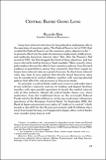Artículo
Central banks going long
Fecha
2019Resumen
Long-term interest rates have for long played an ambiguous role in the operation of monetary policy. The Federal Reserve Act of 1913 that created the Federal Reserve set the monetary policy objective to be: '... to promote effectively the goals of maximum employment stable prices and moderate long-term interest rates.' But after the Treasury Fed accord of 1951 the Fed dropped the third of these objectives and has since referred to itself as having a 'dual mandate.' More recently when policymakers discuss the effect of new monetary policies from forward guidance to quantitative easing they commonly state their impact on longer-term interest rates as a proof of success. As short-term interest rates stay close to zero policies that directly target long-term rates can be considered to control inflation together with macroprudential policies that affect the risk premium in long-term bonds.
Colecciones
Descargar


